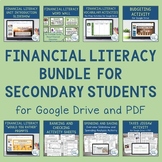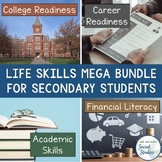Budgeting Activity: Monthly Budget Project and Worksheets for Middle School
- Google Drive™ folder

What educators are saying
Also included in
- Ready to plan out your entire Financial Literacy or Personal Finance unit with one click? This Financial Literacy and Personal Finance Unit Bundle has absolutely EVERYTHING you need to teach about key financial concepts like budgeting, spending, saving, banking, credit cards, taxes, and more! WhethePrice $31.50Original Price $46.00Save $14.50
- This epic collection of Life Skill resources will provide you with no-prep lesson plans and engaging activities at our biggest discount of 40% off! Packed with word walls, vocabulary practice, slideshows, bell ringers, activities, worksheets, projects, and so much more, you have EVERYTHING you needPrice $79.97Original Price $137.47Save $57.50
Description
If you are looking for a no-prep, yet detailed budgeting activity, look no further! In this budgeting activity for Google Drive, students will create a monthly budget. This monthly budget project features the elements of career, housing, transportation, monthly expenses, and more!
This activity was designed to help with budgeting for middle school students, and was implemented in an 8th grade Social Studies class, but it could easily be incorporated in a variety of subjects and grade levels. This particular budgeting activity will take students through five parts of their financial future: their career, their apartment or home, their transportation, monthly costs, and spending/saving. To help prepare students for these activities, they will complete several prompts and make several decisions in each part. As they complete each part, they must make sure they are not going over their budget and are not going into debt.
This resource contains the following:
- Teacher Guide (PDF)
- Editable Monthly Budget Slideshow (for Google Slides)
- Sample Apartments and Homes (for Google Docs + PDF)
- Budget Challenge Handouts (for Google Docs or PDF)
This budget challenge activity has many positive outcomes. It engages ALL students in a way that we don’t always see in the classroom. When thinking about their own futures and making choices about their future careers, students are very actively involved, curious about salaries and prices, and may think about new opportunities that they previously had not thought about. Since there are social elements (such as if students decide they want to live together to save money on an apartment or car), students might even forget they are doing an assignment that can help prepare them for their financial futures.
This Budget Challenge does not require any preparation and is a very thorough, active, and realistic look at budgeting and financial literacy. You can take your students step-by-step using the slides if you’d like, or give them the freedom and time to proceed on their own. My students spent about a week on this Budget Challenge activity, and the concepts highlighted in the challenge sparked further questions and discussion that continued after the activity was over. I know you will find it a very helpful addition to your course content!
Finally, this resource is for Google Drive, which means your personalized copy of the files will go directly to your Google Drive, and they will be ready for you to edit as you wish and share with your students on Google Classroom!
Get this resource along with 10 other helpful financial literacy resources for over 30% off in this bundle, or check out our other financial literacy and personal finance resources by clicking here!







